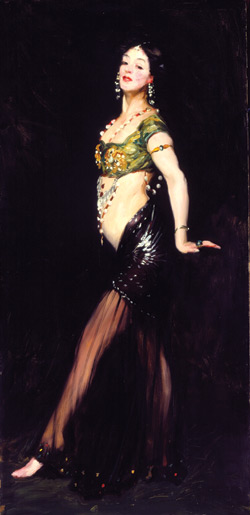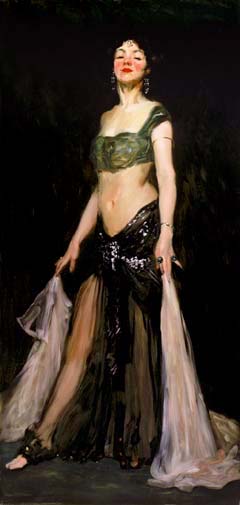SALOMÉ
Robert Henri / American, 1865-1929. SN 937, Oil on Canvas 1909
From: The Pages
ARTIST:
Henri was the leader of the so called Ash Can School, a group of former Philadelphia
newspaper illustrators, who were the first artists to focus on the urban scene. Henri
studied at the Pennsylvania Academy of Fine Arts, Philadelphia, where he was a student of
Thomas Eakins, and also at the Academie Julian in Paris, where he obtained a thorough
understanding of Manet, Velazquez, Rembrandt and Hals. He was introduced to the New York
art world by William Merritt Chase, and taught at the New York School of Art founded by
Chase until 1908 when he founded his own school, where his models were often theatrical
people.
The Ash Can School group painted with broad, bravura brushwork that imparted a certain
spontaneity to their work. This group of "Eight" exhibited their works in open
protest against the restrictive policies of the National Academy of Design. Their work
came to stand for pictorial realism in American painting. Henri himself painted mainly
portraits and landscapes, using impasto brushstrokes and strong chiaroscuro. His work
became progressively more colorful after 1909. Henri's reputation was, however, based on
his ability as a crusader, charismatic teacher, and leader of the Ash Can School. He was a
powerful force in turning young artists away from academia and toward the rich
subject-matter provided by an urban life populated by actors, dancers, prostitutes, and
boxers, among others.
SUBJECT:
The subject of this painting is the Salomé of Richard Strauss' opera, personified by
soprano Mademoiselle Voclezca in the title role.
PAINTING:
This painting provides a characteristic view of the seductive dance of Salomé, with a
brush that traces its sinuous motion. Henri captures the daring dance and its lissom,
exotic motion. This Salomé is a brazen and vital mistress of the dance of the seven
veils. Her long leg is thrust out with a sexual arrogance, and shining through the black
veil is the sexual promise of a thousand women. This lithe female, with glistening skin
and bright red lips, is the personification of all things sensuous.
HISTORIC CONTEXT:
By 1900 the myth of the west as the last frontier had slid into nostalgia. The real
frontier was urban - a place of rapid change where class ground against class. New York
City was its epitome. The Ashcan school were the painters who reported on the City, and
their leader was Robert Henri. His students and followers included John Sloan, George
Bellows, and George Luks, among others; it was they who created the first art of urban
America. Wilde's play and Strauss' opera, entitled Salomé, shocked society with its
realism into a new sexual awareness and Henri's art also played its part.

Ringling Museum |

Clark Museum, Williamstown, MA |
|